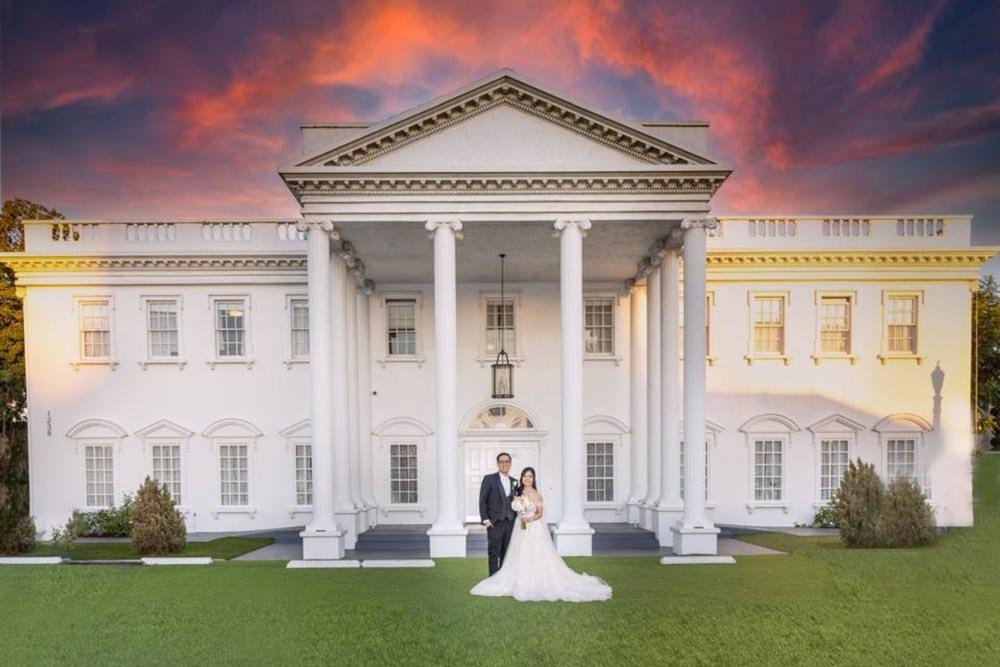Have you ever heard that the white house contains 132 rooms, 35 bathrooms, and the capacity to serve more than 140 people at a time? Today, it stands as a living testament that says a lot about American history and democracy. From its construction in 1792 to the British attack in 1814, it has faced lots of damage.
In this article, we will uncover the secret stories of the white house, its fascinating history, architecture, the challenges it faced throughout the years, some interesting facts, and tourist attractions.
Fascinating History & Architecture of the White House
The Irish-born architect James Hoban designed the White House in the 1790s. The cornerstone was laid on October 13, 1792. Over the next eight years, a construction team of both enslaved and freed African Americans, along with European immigrants built the structure. They used Aquia Creek sandstone for the construction. Stones were coated with lime-based whitewash in 1798, producing a color of white that gave rise to its famous nickname. The construction was not over when John Adams and Abigail Adams became the first residents of the house. It took a cost of $232,732.
Thomas Jefferson gave his opinions on installing two water closets and worked with architect Benjamin Latrobe to add bookending terrace-pavilions in the house. Transforming the building into a more suitable representation of a leader’s home, Jefferson held the first inaugural open house in 1805. He also opened its doors for public tours and receptions for two days: New Year and 4th of July.

After the British attack in 1814, the “President’s House” gave a personal touch to residents. The technology and the installation of electricity were done during this period. Later on, the building’s South and North Porticoes were added in 1824 and 1829, respectively, while John Quincy Adams established the residence’s first flower garden. Subsequently, the administration continued the changes. The Fillmores added a library in the second-floor oval room, and Arthurs hired a famed decorator, Louis Tiffany, to redecorate the dining rooms.
In 1900, the monument underwent several architectural changes under the presidential leadership of Teddy Roosevelt, who later named “President’s House” to “White House”. In 1909, William Taft hired architect Nathan Wyeth to build the Oval Office as the president’s workspace. A fire took place in the house in 1929, which destroyed the executive wing. Somewhere, it fastened the pace of renovations, which continued after Franklin Roosevelt entered the office.
Architect Eric Gugler added a swimming pool in the west wing and moved the Oval Office to the southeast corner. A new east wing was constructed in 1942 and transformed into a movie theater. In 1945, under Harry Truman, the installation of floor-bearing steel beams, and stripping of the building’s interior were done. Truman helped in redesigning staterooms and decorating the second and third floors. Meanwhile, the first computer and the laser printer were installed in the house. In 1992, Internet services started in the House under the watch of George H.W. Bush.
Challenges the Monument Faced Throughout Years
24th August 1814: In the War between the United States and England, British troops stormed the white house. The British troops set fire to the capitol, the president’s house, and other public buildings in Washington. This was a humiliating defeat that struck at the symbolic heart of the country.
16th August 1841: US President Tyler stunned his fellow members of the Whig party by using his constitutional powers to veto a banking bill to revive the Second Bank of the US. When words of his decision spread, angry supporters of the bank gathered outside of the monument. The rioters threw stones and shotguns into the air and hung an effigy of the president that they set on fire. At the time of the incident, the president was living there with his family unprotected and unsafe.
17th February 1974: Landing the helicopter on the white house lawn is a rare privilege, which is reserved only for the most experienced and trusted pilots. But in 1974, a 20-year-old Robert Kenneth Preston with no motor ring certificate, decided to take a run at it.
Henry S. Kulbaski, the watch commander on duty, was notified that an army helicopter had been hovering above the white house and headed for the restricted airspace nearby. Immediately, he warned Kenneth to move back. Kenneth rejected all the orders and, while being chased by the police, he was shot by the Secret Service.

25th December, 1974: On the day of Christmas, Marshall Fields, a 25-year-old crashed his Chevy Impala through the white house gate. The officers caught him immediately. He claimed to be the Messiah and threatened to detonate what appeared to be a bomb strapped to his body. After 4 hours of heavy negotiations, Fields surrendered.
22nd March 1984: Anthony Holbert, a 22-year-old, parked near the northwest White House gate on Pennsylvania Avenue and approached the executive mansion. He pulled a samurai sword from a scabbard and waved it in the air at Ronald Reagan. Sensing the men to be mentally unstable, officers persuaded Holbert to lay down his weapon and surrender.
16th March 1984: An electrician, David Mahonski, with a drug abuse problem, threatened Reagan and often loitered around the white house. One day, security agents noticed him outside the fence. As they approached him, he drew a sawed-off shotgun. An officer immediately shot him in the arm. Mahonski was arrested and ordered to undergo psychiatric treatment.
12 September 1994: An army veteran and the former truck driver Frank Eugene Corder crashed a stolen Cessna into the south wall of the White House. Corder died immediately at the point of incidence. Since the monument was undergoing renovations at the time, President Bill Clinton and his family were not in the house.
Interesting Facts About White House
- White House didn’t have electricity for nearly 100 years. It was lit entirely by the gas lights until 1891 when electricity was installed for the first time.
- It has been home to several deaths. To date, a total of 10 people have died within the walls.
- It is a popular wedding spot. There have been several weddings at the white house since it was built.
- A secret entrance was designed in part as a response to the Second World War. It was an underground shelter that was built beneath the white house.
- Inside the white house, there is a movie theatre that was built during the administration of Franklin D Roosevelt. Presidents enjoy the private screening here without leaving the premises of the monument.
- It was originally called “President’s Palace”, “President’s House”, or “Executive Mansion” until President Theodore officially named it the “white house”.
- The monument is made of white-painted Aquia sandstone. It is painted white to protect the porous stone from weather changes.

Tourist Attraction
Over the years, the white house has become an American historic site, attracting more than 1.5M visitors annually. You can tour the house as a tourist depending on your home country. You have to contact your embassy or confirm your residency in Washington DC.
US departments prioritize foreign citizens over US citizens. But if you’re a US citizen and you wish to tour the White House, then you need to plan it well in advance. Requests need to be made through your member of Congress at least 3 months in advance.
If you’re planning your tour in spring or autumn, you can also visit the white house garden. The tickets are available on the website.
Tips for Travelers To Get the Best Views of the House
Pennsylvania Avenue NW and Lafayette Square are the two points where you can see the beauty of the white house. Here, you can see the Washington monuments as well.
If you’re visiting in December, you can get a beautiful view of the decorated national Christmas tree on the lawn of Ellipse. Each year in late November or early December, it is lit by the president and the first lady. There is a pathway of peace around the tree where you can see the 58 smaller Christmas trees that represent each of the states and territories of the nation.
There is one building that is worth seeing – The U.S. Capitol. They allow only a limited number of people at a time. So if you don’t book it online, you can miss the opportunity. You need to bring your ID when collecting your tickets at the Capitol Visitor Center. There are also beautiful works of art in the house that you should not miss.
Conclusion
America is full of hidden gems, but none quite as grand as an iconic white house in Washington DC. Its history and architectural symbolism are truly awe-inspiring. Built from locally quarried Aquia Creek sandstone, the building itself is a testament to American craftsmanship. People all across the globe visit here to see this unforgettable sight. Plan your next trip to this amazing destination.









